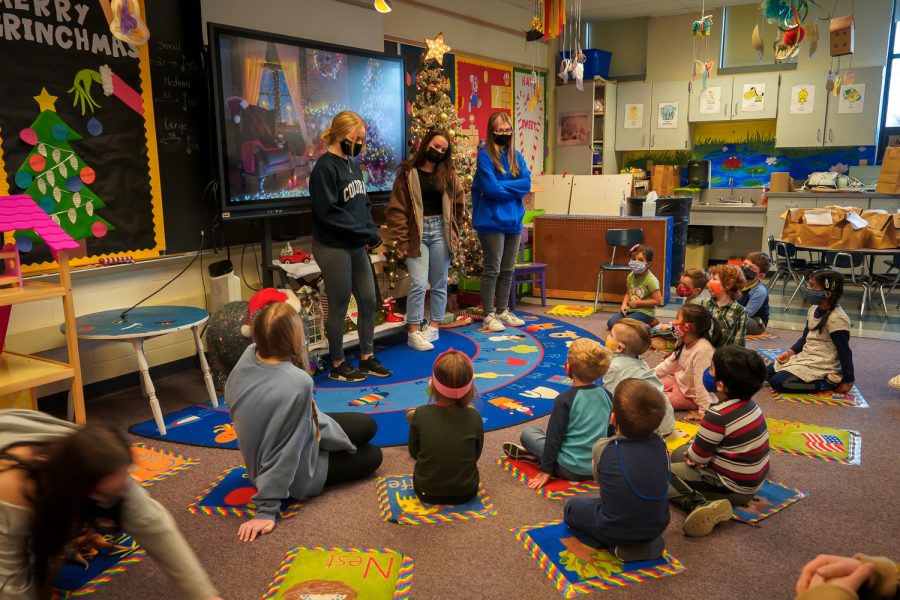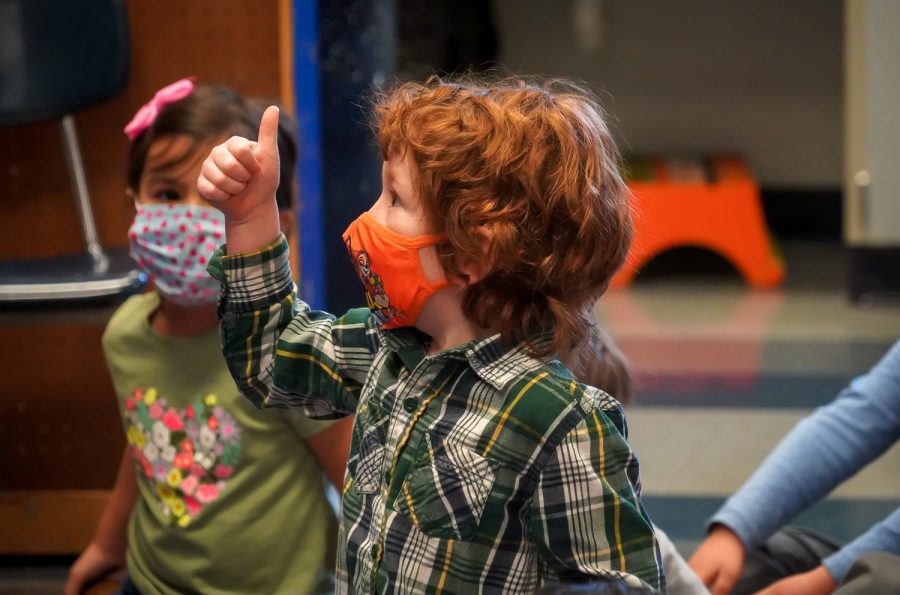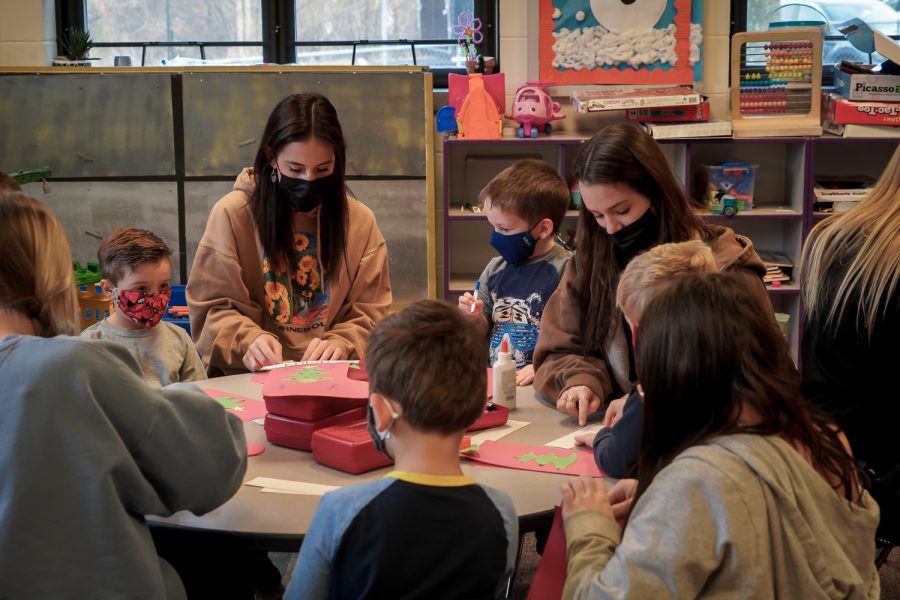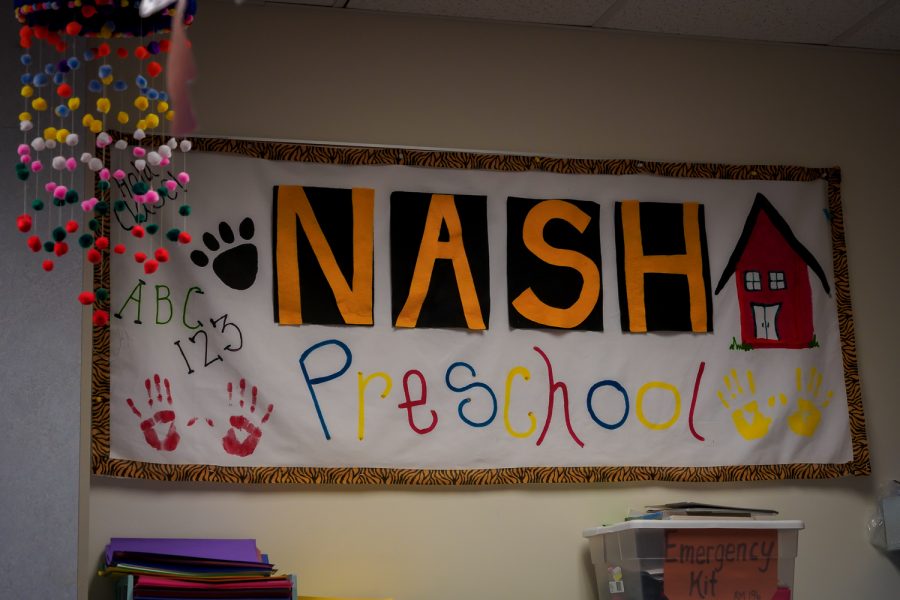Of Mutual Benefit
NASH’s Preschool Practicum not only serves community parents but also forms bonds between their children and the high school students who enroll in the class.
NASH’s Preschool Practicum is one of the building’s best-kept secrets, and it may point the way toward a national solution to the ongoing daycare crisis.
At 8:15 AM on Tuesdays, Wednesdays, and Thursdays, North Allegheny Senior High School sees a second wave of morning drop-offs. This time, the students who say goodbye to their parents and scamper into the school are no taller than the waists of the high school students who greet them in Mrs. Loeffert’s room at the end of the FCS hallway.
NASH’s Preschool Practicum combines classroom learning with real-world experience. Seniors who take the class spend two days of the week learning about early childhood development and creating lesson plans. The rest of their time is spent with the preschoolers–teaching, playing, and bonding.

NA Preschool is different from what most Americans think of as daycare. However, it is precisely the program’s unique format that makes it a potential solution for the child-care crisis ramping up in America.
The issue is two-fold. Child-care work is difficult, as it requires extensive attentiveness and energy. However, most daycare employees make less than $20 an hour. This has resulted in a severe labor shortage in daycare centers across America.
Although the employees receive so little, child-care in America remains an intense monetary burden to most families. At present, families of young children allocate around 13% of their annual income to child-care. The lack of employees has also reduced the number of children preschools can accept. Competition for spots at a child-care center is so extreme that many families rearrange their lives to be able to get their children in.
The North Allegheny Preschool is an interesting exception to this nationwide issue.
First of all, parents pay only $200 per year to send their children to NA Preschool. Compare that to the average $10,000 parents of children under five years old pay for day care in America.
Second, student demand for the course is especially strong, making labor shortages a non-issue. For the seniors in the Preschool class, spending time with the younger children is an adorable treat.
“There’s one girl that kind of looks like Dora. Her name’s Natalia, and I think she’s so cute,” senior Kaitlin Chou gushed. “There’s another kid named Kenny who is just so tiny.”

The simple innocence and joy radiated by the preschoolers makes a period of Preschool class a welcome break in high school seniors’ days.
“The class is entertaining. There was one time when the kids were all dancing, and I was just dancing with them,” senior Cole Sevacky recalled as he demonstrated his dance moves.
The quality time spent together has resulted in the formation of friendships between the older and younger students.
“They definitely know us,” senior Katie Zimsky said with a smile. “They will come and play with us and pick us out. I think that’s so cute.”
Due to the educational purpose of the class, NA Preschool is not licensed by the state like other independent child-care centers; however, it certainly does not lack in the quality of education it gives its attendees.
Some NASH teachers, such as Mr. Omasits, currently enroll their children in NA Preschool.
“[The program] is awesome,” Omasits said. “Mrs. Loeffert works really hard to plan things and get [the children] ready for Kindergarten.”
Mr. Kyriazis, one of NASH’s physical education teachers, put both his daughter and his son in the NA Preschool. He related how beneficial the high school students were to both the program and his children’s experiences.
“You have Mrs. Loeffert teaching the seniors, the seniors teaching the preschoolers, and then just everyone working together. It works really well,” Kyriazis said. “I think that the preschoolers really embrace being there with [students] they look up to.”
Mr. Omasits echoed those comments with details about his own daughter’s experience.
“The seniors really make the program. Being friends with the seniors that are there, she looks forward to seeing them,” he said. “She really likes that I can talk about them from class, too. If one of the seniors doesn’t do their homework and I tell Frankie, she thinks that’s really funny.”

Additionally, the sheer number of high school seniors in each class period is one of the program’s chief benefits, with around 13 seniors for 15 preschool students.
‘It’s so nice because [the preschoolers] have independent help. We can teach in a big group. We can do centers. And if someone is struggling, they can get one-on-one help,” Loeffert explained.
However, there are several obstacles that prevent North Allegheny Preschool from being the perfect solution for parents of young children. The class only allows for half-days, so parents must choose to send their children either to the morning or afternoon session. For families with two full-time working parents, the choice can be impossible.
Additionally, the program is only open to those residing in the North Allegheny School District.
But the drawbacks pale in comparison to the greater potential of preschools integrated within high schools. If the potential of similar programs across the country is harnessed, high schools may provide a viable pathway to a national crisis in need of a swift and comprehensive solution.
___________________________________________________________________________________
To learn more about the child-care crisis in America, click here and listen to an episode of The New York Times‘ podcast The Daily.

Michelle Hwang is a senior at NASH and the features editor for The Uproar. She enjoys reading, so if you happen to have any book recommendations, please send them her way. And if you happen to have spare slices of pecan pie lying around, send those her way too. She really likes pecan pie. She also likes making pros and cons lists with Claire Majerac. Not about pecan pie though. There are no cons to...



